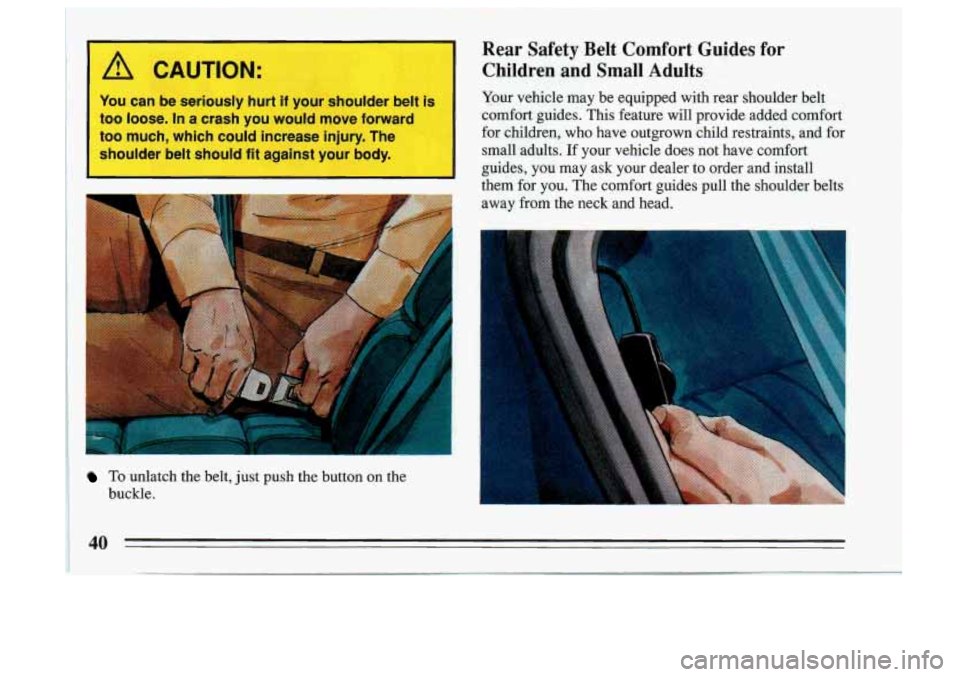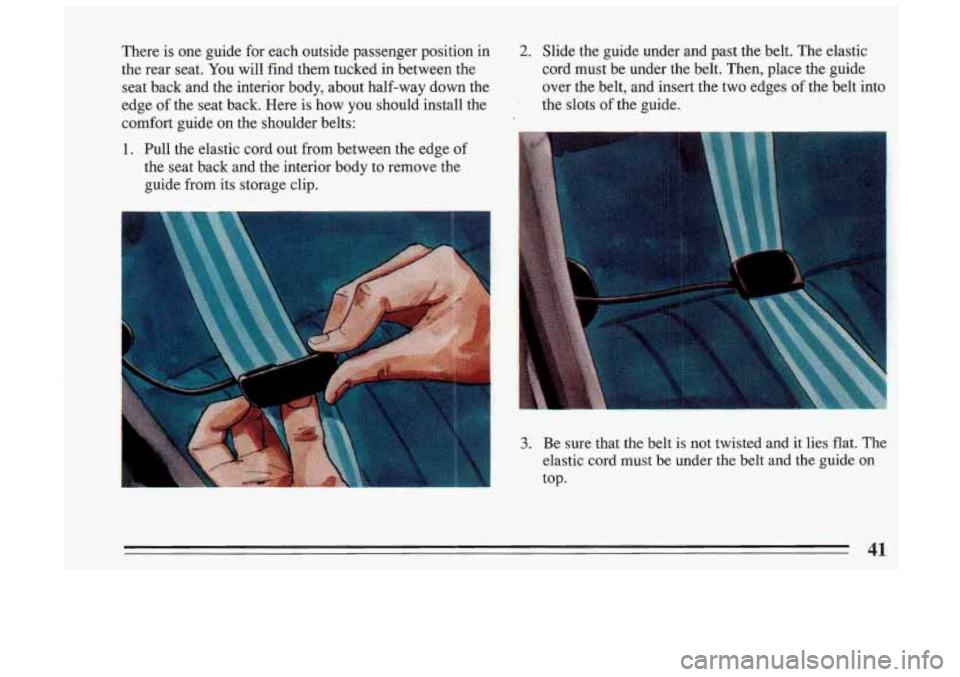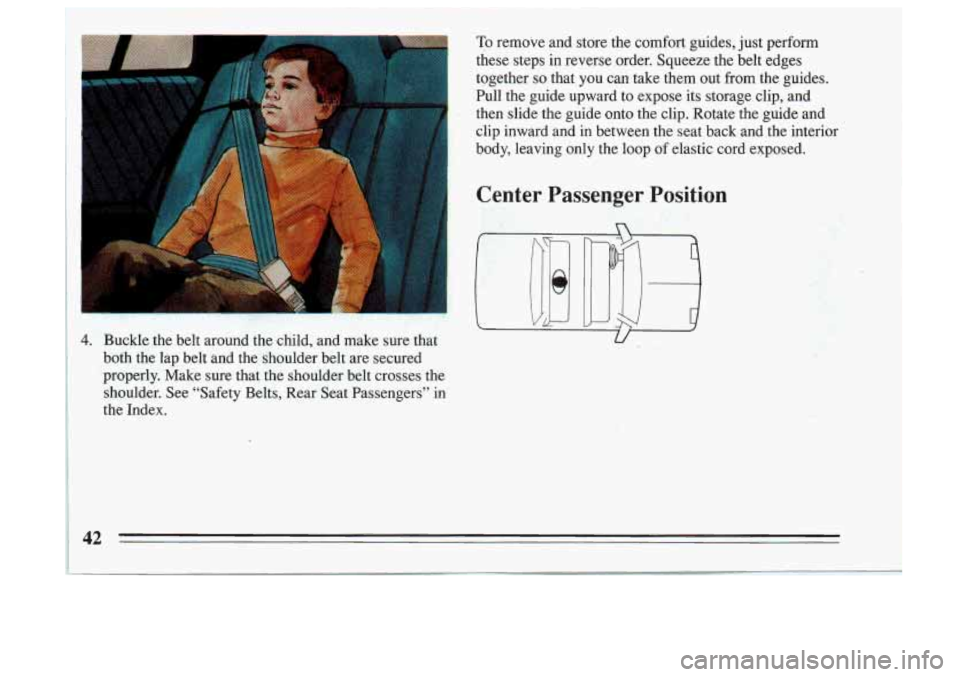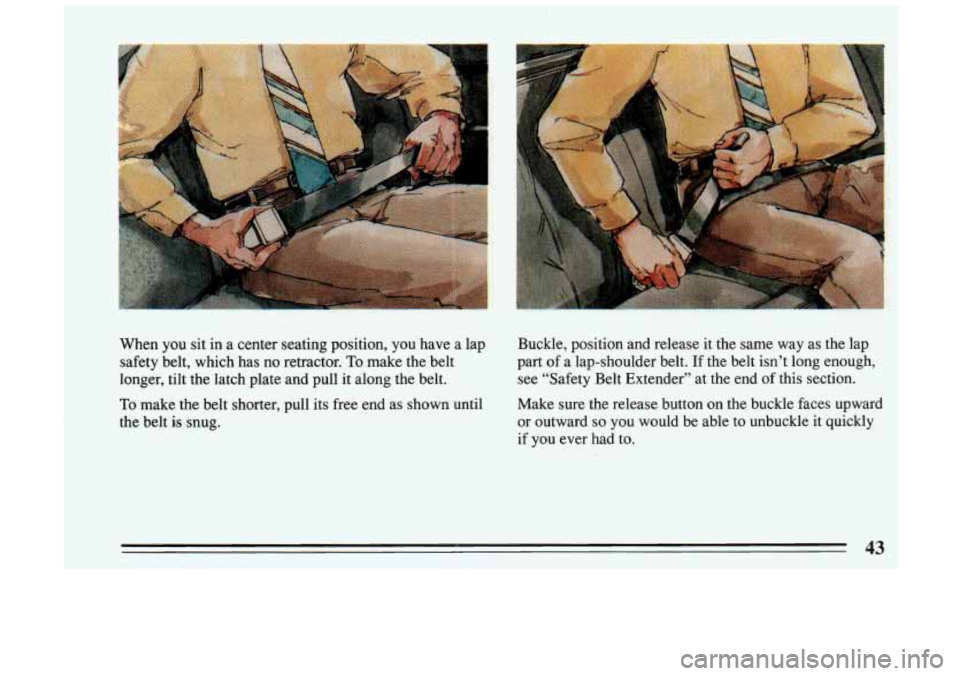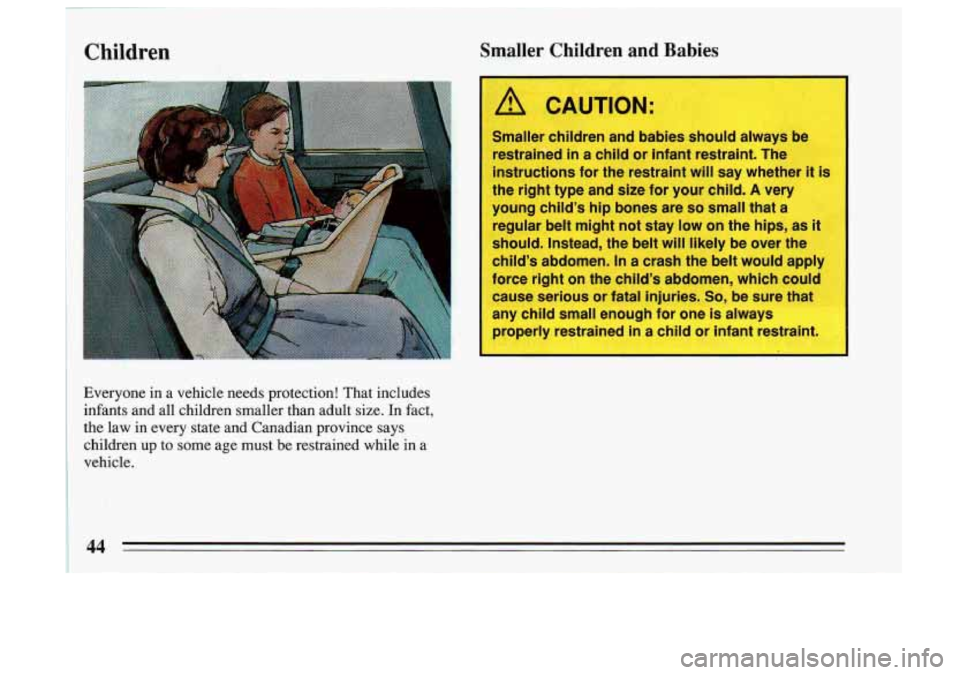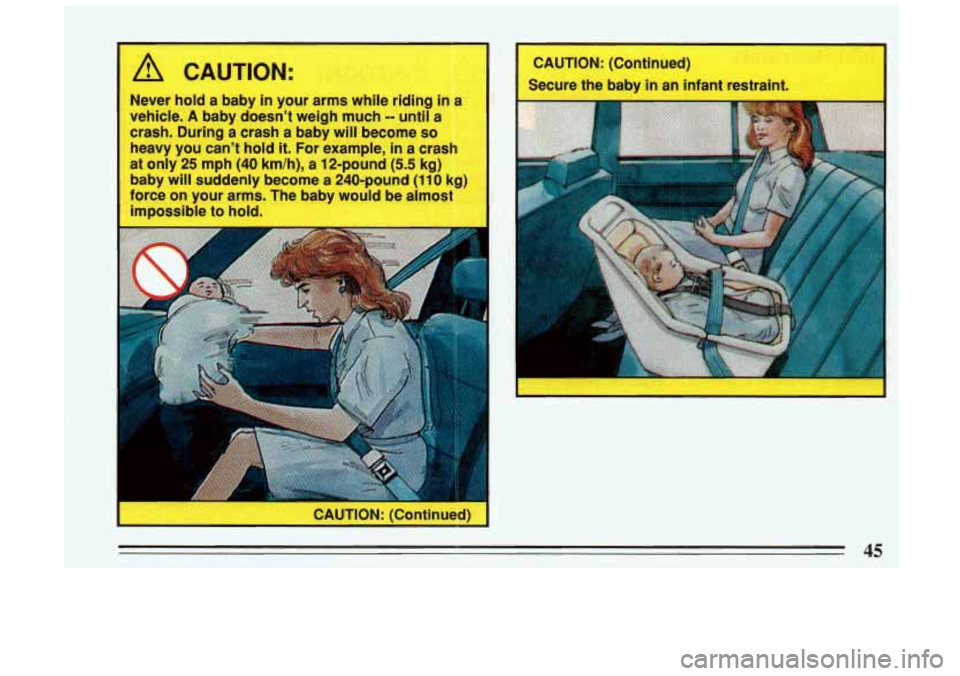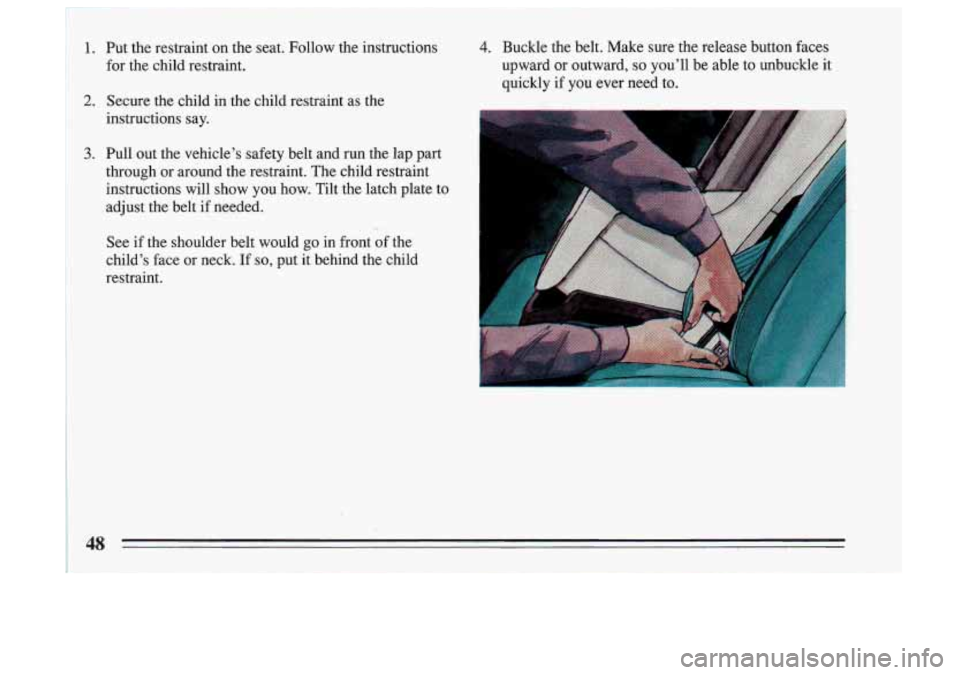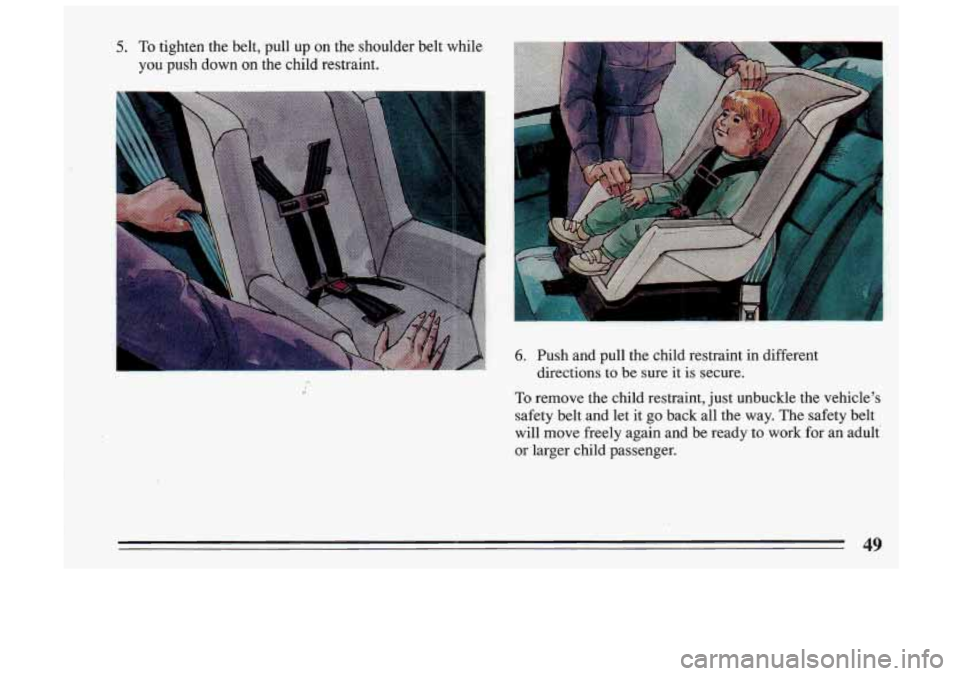BUICK SKYLARK 1993 Service Manual
SKYLARK 1993
BUICK
BUICK
https://www.carmanualsonline.info/img/43/57703/w960_57703-0.png
BUICK SKYLARK 1993 Service Manual
Trending: open gas tank, service schedule, fuel pump, engine oil, steering wheel, night vision, oil capacities
Page 41 of 306
A CAUTION:
You can be seriously hurt if your shoulder belt is I
too loose. In a crash you would move forward
too much, which could increase injury. The
shoulder belt should fit against your body.
To unlatch the belt, just push the button on the
buckle.
Rear Safety Belt Comfort Guides for
Children and Small Adults
Your .vehicle may be equipped with rear shoulder belt
comfort guides. This feature will provide added comfort
for children, who have outgrown child restraints, and for
small adults.
If your vehicle does not have comfort
guides, you may ask your dealer to order and install
them for you. The comfort guides pull the shoulder belts
away fi-om the neck and head.
Page 42 of 306
There is one guide for each outside passenger position in
the rear seat. You will find them tucked in between the
seat back and the interior body, about half-way down the
edge of the seat back. Here is how you should install the 2. Slide the guide under and past the belt. The elastic
cord must be under the belt. Then, place .the guide
over the belt, and insert the two edges of the belt into
the slots
of the guide.
41
Page 43 of 306
4. Buckle the belt around the child, and make sure that
both the lap belt and the shoulder belt are secured
properly. Make sure that the shoulder belt crosses the
shoulder. See “Safety Belts, Rear’ Seat Passengers” in
the Index.
To remove and store the comfort guides, just perform
these steps in reverse .order. Squeeze the belt edges
together
so that you can take them out from the guides.
Pull the guide upward to expose its storage clip, and
then slide the guide onto the clip. Rotate the guide and
clip inward and in between the seat back and the interior
body, leaving only the loop
of elastic cord exposed.
Center Passenger Position
U
42
Page 44 of 306
When you sit in a center seating position, you have a lap
safety belt, which has no retractor.
To make the belt
longer, tilt the latch plate and pull it along the belt.
To make the belt shorter, pull its free end as shown until
the belt
Is snug. Buckle, position
and release
it the same way as the lap
part of a lap-shoulder belt. If the belt isn’t long enough,
see “Safety Belt Extender’’ at the end of this section.
Make sure the release button on the buckle faces upward or outward
so you would be able to unbuckle it quickly
if you ever had to.
43
Page 45 of 306
Children
A CAUTION:
Smaller children and babies should always be
restrained in
a child or infant restraint. The
instructions for the restraint will say whether it is
I
the right type and size for your child. A very
young child’s hip bones are
so small that a
regular belt might not stay low on the hips, as it
should. Instead, the belt will likely be over the
child’s abdomen. In a crash the belt would apply
force right on the child’s abdomen, which could
cause serious or fatal injuries.
So, be sure that
any child small enough for one is always
Droperly restrained in
a child or infant restra
Everyone in a vehicle needs protection! That includes
infants and all children smaller than adult size. In fact,
the law in every state and Canadian province says
children up
to some age must be restrained while in a
vehicle.
44
Page 46 of 306
A CAUTION:
Never hold a baby in your arms while riding in a
vehicle.
A baby doesn’t weigh much -- until a
crash. During a crash a baby will become
so
heavy you can’t hold it. For example, in a crash
at only 25 mph
(40 km/h), a 12-pound (5.5 kg)
baby will suddenly become
a 240-pound (110 kg)
force on your arms. The baby would be almost
impossible to hold.
L
Page 47 of 306
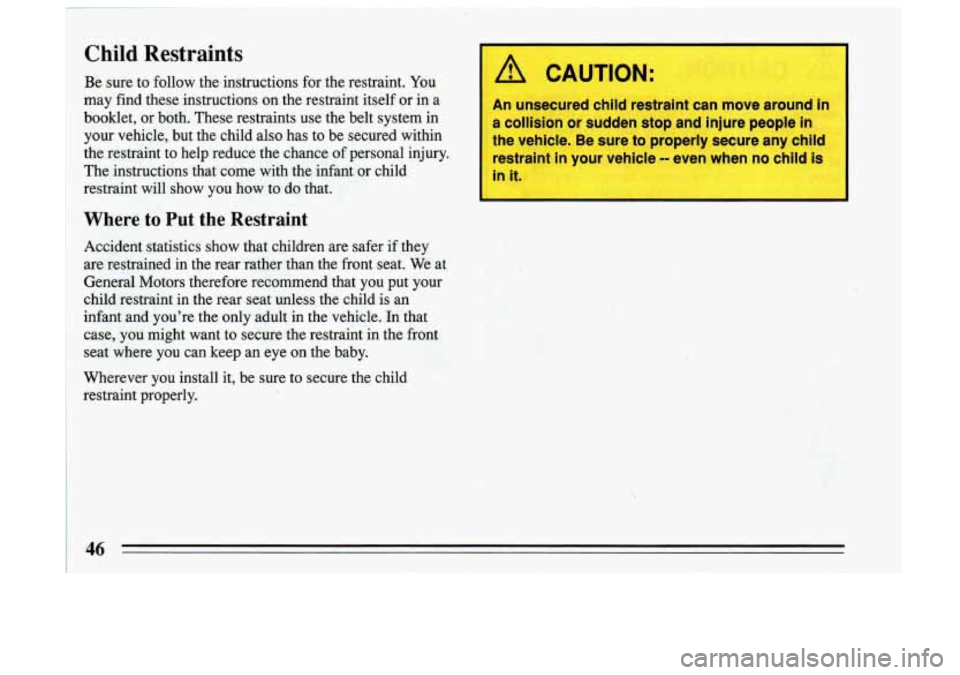
Child Restraints
Be sure to follow theinstructions for the restraint. You
may find these instructions on the restraint itself or in a
booklet, or both. These restraints use the belt system in
your vehicle, but the child also has to be secured within
the restraint to help reduce the chance of personal injury.
The instructions that come with the infant or child
restraint will show you how to do that.
1 Where to Put the Restraint
Accident statistics show that children are safer if they
are restrained in the rear rather than the front seat. We at
General Motors therefore recommend that you put your
child restraint
in the rear seat .unless the child is an
infant and you’re the only adult in the vehicle.
In that
case,
you might want to secure the restraint in the front
seat where you can keep an eye
on the baby. !. , . ...:
Wherever you install it, be sure to secure the child
2 ;. ,% #;$, :<.. 3,
I restraint properly.
. . <-
I A CAUTION:
An unsecured child restraint can move around in
a collision or sudden stop and injure people in
the vehicle. Be sure to properly secure any child restraint in your vehicle
-- even when no child is
in it.
Page 48 of 306
Page 49 of 306
1. Put the restraint on the seat. Follow the instructions 4. Buckle the belt. Make sure the release button faces
for the child restraint. upward or outward,
so you'll be
able to unbuckle it
quickly if you ever need to.
z4 ,Secure the child in the child restraint as the
.. :instructiom say.
3. Pull out the vehicle's safety belt and run the lap part
through or around the restraint. The child restraint
instructions will show you how. Tilt the latch plate to
adjust the belt if needed.
See if the shoulder belt would
go in front of the
child's face or neck.
If so, put it behind the child
restraint.
48
Page 50 of 306
5. To tighten the belt, pull up on the shoulder belt while
you push down on the child restraint.
To remove the child restraint, just unbuckle the vehicle's
safety belt and let it go back all the way. The safety belt
will move freely again and be ready to work for an adult
or larger child passenger.
49
Trending: fuel additives, oil change, windshield wipers, towing, fuel, jump cable, change key battery
